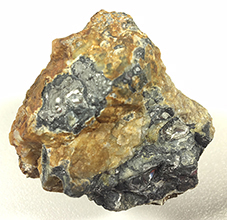arsenic antimonide (AsSb)
or antimony arsenide. The name stibarsen is derived from
Latin stibium (antimony) and arsenic.
Allemonite refers to the locality Allemont where it is found in veins
at Allemont, Isère, France. It ranges in colour from white, gray,
grayish white and can be reddish white on fresh surfaces.
It occurs in Reniform ("kidney like") structure.
Any mixture of arsenic and antimony
that has 80% or more of one element is classified
as that element. Eg. a specimen with a ratio of 80% arsenic
and 20% antimony is recognised as Arsenic.
Conversely, a specimen with 80% antimony
and 20% arsenic is recognised as Antimony. Any combination with less
than 80% of either arsenic or antimony is classified as Stibarsen.
STIBARSEN FIELD INFORMATION
Prospectors for minerals frequently use metal detectors
as an adjunct to traditional mineral exploration methods
such as field reconnaissance, rock chip and soil sampling.
Whilst exploring a parcel of country in the Palmer River area
carrying metal detectors at the time while navigating a small,
well incised gully one of the team obtained a metal detector signal.
What appeared to be a small thumb-sized rock was the culprit.
Breaking this rock open revealed a silvery metallic interior.
At first it was thought to be some sort of slag from
historical explorers casting metal. However, more intense
scrutiny of the area resulted in many more nodules being found.
Returning home an XRF analysis of a sample revealed
the material to be Native Antimony.
Attempts were made to locate the source of the nodules
and it was suspected that they formed at the nearby
interface between a mylonitic Granite and Amphibolite
of Meso Proterozoic age that subsequently underwent
siluro-devonian deformation and metamorphism.
Subsequent exploration of the surrounding area
uncovered sporadic nodules over a wide area.
Historical diggings were located about
700 Metres distance from the original find.
At his location a 5 kg piece of unknown metallic mineral was located
which after tests the material was identified as Stibarsen.
After extensive exploration the source was eventually located.
The Stibarsen is hosted in a vein breccia with the “outcrop”
flush with the ground surface. The exact locality is a secret.
STIBARSEN SPECIMENS FOR SALE.
 STIBARSEN Palmer River Area,Far North Queensland, Size: Weight
| |||
|---|---|---|---|
 STIBARSEN Palmer River Area,Far North Queensland, Australia Size: |
|||
|
for displaying and protecting your favourite minerals, gems, fossils, meteorites or other collectibles. We also make mineral display stands and acrylic blocks. FOLLOWING LINK BELOW: And DISPLAY PRODUCTS |
This website was designed by Gerald Reginald Pauley
All Rights Reserved.